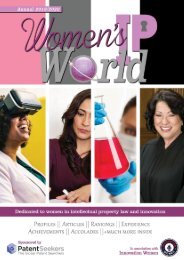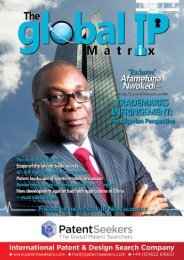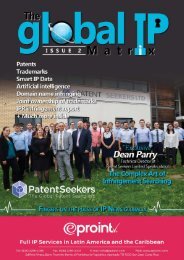Global IP Matrix - Issue 5
It has been a fantastic year for The Global IP Matrix magazine, thanks to all the efforts made by our contributors and to you, the reader for your continued support. We take great pleasure in putting together each issue of this publication, and we sincerely hope you enjoy this final issue of 2019. We have again, collaborated with some of the world's most influential IP law firms and businesses to bring you another eclectic mix of content, direct from the professionals working at ground level. We are already excited for the coming year and cannot wait to continue growing and evolving in our partnerships to bring you some exciting new features for 2020. Ms. Elvin Hassan Editor & Head of international liaisons
It has been a fantastic year for The Global IP Matrix magazine, thanks to all the efforts made by our contributors and to you, the reader for your continued support. We take great pleasure in putting together each issue of this publication, and we sincerely hope you enjoy this final issue of 2019. We have again, collaborated with some of the world's most influential IP law firms and businesses to bring you another eclectic mix of content, direct from the professionals working at ground level. We are already excited for the coming year and cannot wait to continue growing and evolving in our partnerships to bring you some exciting new features for 2020.
Ms. Elvin Hassan
Editor & Head of international liaisons
Create successful ePaper yourself
Turn your PDF publications into a flip-book with our unique Google optimized e-Paper software.
PATENTS<br />
Don’t sugar-coat it:<br />
the sweet story of diabetes<br />
An overview of diabetes treatment and its patent landscape.<br />
Bio: Filip Silvestre (BSc Biotechnology)<br />
is a Senior Analyst on the Biotech team<br />
at Patent Seekers (A leading patent<br />
research company based in the UK<br />
and Canada). Filip is an experienced<br />
searcher and has worked on a wide range<br />
of casework on a variety of topics. His<br />
specialisms are therapeutics, surgical<br />
devices, pharmaceuticals, and genetic<br />
engineering. Filip took this opportunity<br />
to explore the current patent landscape<br />
around diabetes treatments and<br />
provided an insight into some of the<br />
most innovative technologies that are<br />
currently being developed.<br />
Filip Silvestre, Senior Analyst, Biotech team at Patent Seekers<br />
www.patentseekers.com<br />
How rapidly is innovation taking place in this space?<br />
The increasing trend in diabetes frequency is mirrored in the patent landscape, as shown in Figure<br />
1. An increase in diabetes-related patent filings is evident, with a peak in 2015-2016. The increase in<br />
patent filings could be explained by an increase in the prevalence of diabetes, which has resulted in a<br />
greater burden on the healthcare systems. The frequency of diabetes is predicted to continue increasing;<br />
hence, it may be rational to assume a continued increase in patent filings. The recent increase in patent<br />
filings further supports this assumption, as approximately 20% of patent filings appear to be in 2015-<br />
2017. The apparent reduction in patent filings in 2018 is most likely explained by applications yet to be<br />
published that would be claiming these years as a priority, as there is an 18-month delay between the<br />
filing of an application and its publication.<br />
Introduction<br />
Diabetes is a metabolic disorder that is<br />
subdivided into two main subtypes: type<br />
I and type II. The onset of diabetes is a<br />
result of a complex interplay between a<br />
range of genetic and environmental factors.<br />
While type I diabetes is characterised by<br />
the autoimmune destruction of insulinproducing<br />
beta cells in the pancreas, type<br />
II diabetes is generally a result of insulin<br />
resistance or impaired insulin secretion.<br />
Both types are characterised by poor<br />
glycaemic control, wherein blood glucose<br />
levels are frequently elevated for prolonged<br />
periods. Recurring hyperglycaemia<br />
imposes a higher risk of developing diseases<br />
such as cardiovascular disease, diabetic<br />
retinopathy, and kidney failure.<br />
This article will analyse the patent landscape in<br />
the fight against diabetes, along with exploring<br />
some of the more interesting, cutting-edge<br />
technologies that are being used to treat patients<br />
suffering from this disease.<br />
The rising occurrence of diabetes is posing a<br />
tremendous challenge for healthcare systems<br />
around the world. According to the International<br />
Diabetes Federation, the number of people<br />
suffering from diabetes worldwide has increased<br />
by 314 million between 1980 and 2014 and is<br />
predicted to continue increasing. A significant<br />
portion of this increase is attributable to type<br />
II diabetes, or often referred to as diet-induced<br />
diabetes, wherein poor diet and sedentary<br />
lifestyle are considered to be the leading causes<br />
for the epidemic.<br />
Figure 1. Worldwide patent filings in the last 20 years.<br />
In accordance with the increasing demand and patent filings in this field, this area is ranked as one of<br />
the most important for the future by the <strong>Global</strong> Innovation Index (The <strong>Global</strong> Innovation Index (GII)<br />
2019 ranks and breaks down the innovation performance of 129 countries and economies around the<br />
world). We will now explore how the technology landscape has changed over this period of growth<br />
and innovation.<br />
What are the trends in technology focus?<br />
Considering the complexity of diabetes, it should be of no surprise to expect a wide range of innovation.<br />
Figure 2 illustrates a heatmap showing the number of patent publications categorised in the top 20<br />
CPC classifications over the last 20 years. It is apparent that innovation in this field encompasses a<br />
range of different technology areas, focussed on the different challenges posed by diabetes. The two<br />
main areas of innovation appear to be pharmaceuticals (A61K & C07) and medical devices (A61B5),<br />
with pharmaceuticals dominating the landscape. A look at the recent trend in patent publications may<br />
provide us with an insight into the future focus of innovation, the three classes with the most patent<br />
publications since 2015 are listed below. Interestingly, most of the identified areas are not related to<br />
pharmaceuticals.<br />
4 www.gipmatrix.com












